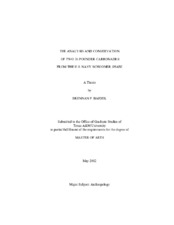| dc.description.abstract | In February of 2008, two 18-pounder carronades were discovered off the Oregon coast near Arch Cape in Clatsop County. In addition to the carronades, several associated artifacts were collected from the site, including lengths of chain, a heavy iron wedge and a mooring shackle. The carronades and associated artifacts were transported to Texas A&M University's Conservation Research Laboratory for long-term preservation and conservation.
While the primary objective of this thesis is to detail the various methods used in conserving the Arch Cape artifact assemblage, the work also serves as an analysis of the carronades themselves. The design and caliber of the guns as well as historic accounts suggest the carronades are associated with Shark, a U.S. Navy schooner built at the Washington Navy Yard in 1821. During its 25-year career, Shark spent 18 years operating in the Atlantic Ocean suppressing piracy in the West Indies and the slave trade off the western coast of Africa. The schooner was also stationed in the Mediterranean Sea and the Pacific Ocean before a final survey in the Oregon Territory in 1846 resulted in its loss in the Columbia River.
It was reported that part of Shark's wreckage with three attached carronades came ashore south of Hug Point. In January 1898, a winter storm revealed one of the carronades, which was recovered, along with the schooner's capstan, a cleat and a chock. The discovery of the pair of carronades in 2008 is strong evidence that these, along with the carronade recovered in 1898, are the three guns attributed to USS Shark's wreckage.
This thesis will also analyze indentifying features on the carronades, such as maker's marks and serial numbers, and explore the origins of the guns, determining how they came to be on board the American schooner by referring to records such as the Woolwich proof books and armament lists.
The harsh conditions of the coastal environment affect the assemblage in a number of ways. While much of the metal of the assemblage is stable and can be treated using electrolysis, the delicate organic materials must undergo specific treatments. Since these organic artifacts were treated primarily with silicone oil, the thesis will compare some of the final results of using this polymer passivation technology with different materials, such as wood, leather and cordage.
Finally, in addition to detailing the conservation of the assemblage, this thesis describe the reverse engineering required to disassemble the carronades and gun carriages. | en |


